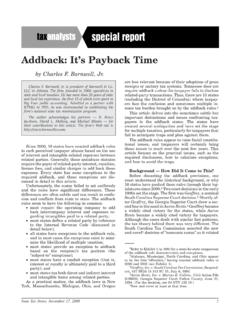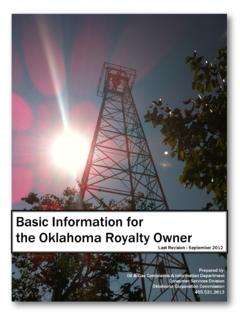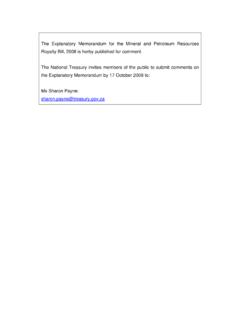Transcription of A Simple Method For Calculating A “Fair” Royalty …
1 September 2011210 Royalty RateA Simple Method For Calculating A Fair Royalty RateBy Damien SalauzeIntroductionuring a licensing deal ( license of a patent protecting a product), several methods are commonly used to determine what is intend-ed to be a fair Royalty rate. It is even recommended to combine several methods in order to cross-check that there is no discrepancy between one Method and another. These methods fall into three typical groups [1-4]: (i) comparison with previous similar deals done by others, (ii) alignment with industry or internal practice, and (iii) calculation.
2 In light of a common experience, it appears that com-parison with previous similar deals is always question-able because, even if data are extracted from a reliable database, negotiators have the feeling that no deal is really similar to the deal they are currently with industr y or internal practice is generally frustrating when one of the parties does not belong to the industry ( an academic institution), or when one of the parties has limited bargaining power. Therefore, sentences such as we have always done it like that, or there is no way that the rate should be out of this usual range, are very unlikely to create a win-win is often felt to be more rational.
3 However, calculation may rapidly become complex, especially if one takes into account probabilities and wishes to introduce options, and relies heavily on the assumptions that are introduced [4]. In addition, calculation-based methods usually do not take into account the amount of money to be invested by the licensee to license and its subsequent associated risk. At Institut Curie, which is an academic research institution, we have introduced a relatively Simple calculation-based Method which allows sharing the benefit made by the licensee and which - ver y important - takes into account both the amount of money to be invested by the licensee further to license, and its subsequent associated risk.
4 This Method is so far satisfactorily used, in the sense that its outcome is felt by parties to be both rational and fair. This Method is applicable to any kind of busi-ness, although Institut Curie is primarily involved in life sciences (it is a Paris-based Comprehensive Cancer Center created one centur y ago by Marie Curie when she received her second Nobel Prize).Parameters to be Taken Into ConsiderationAt this stage, let s consider a pure Royalty -based calculation (there is no upfront payment, no mile-stone payments, and royalties are a percentage of the sales of the product protected by the patent).
5 Let s also consider that the license is an exclusive license, and let s exclude sub-license issues. The typical case is that of the license of a patent (considered as grant-ed), that protects a product which is still in the development stage ( several years are still needed prior to marketing, and significant investment is still needed to be made, at a certain level of risk). In fact, Royalty is nothing else than a share of the benefit made by the licensee, which is paid to the licensor. Therefore, three questions arise at this stage: (i) how to define the benefit ?
6 (ii) how to take into account the investments to be made prior to marketing stage, the required time to develop the product, and the associated risk? and (iii) how to share the benefit ?There is no universal definition of benefit. De-pending on the country (many deals are concluded between parties coming from different countries where accounting principles and/or habits are differ-ent), depending on the perspective ( operating, accounting, financing, ..), benefit covers different notions. For example, accounting benefit which is the easiest to access since it is included in the profit and loss statement of every company, neither reflects the level of investment of a company for developing a product, nor the financial risk taken by the licensee.
7 Its format in many countries is set-up for tax reasons, and is therefore not easy to handle for the purpose of Royalty rate determination. Let s, therefore, introduce a for the purpose of Royalty rate calculation benefit called B. B is calculated after establishment of a simplified provisional profit and loss statement (SPPLS) related to the product protected by the patent (see Table 1 D Damien Salauze, Institut Curie VP, Business Development & Licensing, Paris, France E-mail: Nouvelles211 Royalty Rateand Table 2). In order to establish SPPLS, one has to consider two phases: (i) pre-marketing phase dur-ing which there are only expenses and no revenues (R&D costs, registration costs, pre-production costs, pre-marketing costs.)
8 See Table 1, and (ii) market-ing phase during which there are still costs (residual R&D costs, production costs, marketing costs, ..), which are hopefully balanced by revenues see Table 2. Between these two phases, there is what we call moment zero (M0), which may correspond for drugs to the day the marketing authorization is granted. In fact, this is just a virtual moment, taking place between December 31st of year-1 and January 1st of year+1, allowing calculation of the present value of of the first phase are added year by year, after application of a discount rate in order to take into account the financial risk taken by the licensee.
9 This rate is generally between 8 and 20%. It reflects the risk taken by the licensee at investing financial resources in the project ( the return on investment the licensee would have had if it would have invested these resources in its current business). Thus, 100 Euros invested one year prior to M0 account for 115 Euros if the discount rate is 15% (discounting factor DF = ). On the same basis, 100 Euros invested three years prior to M0 account for 100 x , thus 152 Euros. The invested amounts during this pre-marketing phase take into account all the expenses that the licensee has to make in order to market the considered product.
10 All these costs are summed up, the sum being called . = Z x (DF)n + .. + C x (DF)3 + B x (DF)2 + A x (DF)1 This will have to be amortized during the second period ( deducted from revenues for the calculation of B). Arbitrarily, it is proposed that be amortized over a 10-year period if the patent expires later than ten years after M0, and therefore, /10 is added each year to provisional costs of the second phase during the first ten the second period, costs are deducted from revenues. These costs include not only as explained earlier, but also production costs (all costs incurred by licensee to produce units of product sold), market-ing costs (all costs paid by licensee to market units of product sold), and sometimes residual R&D costs (all potential direct R&D expenses that licensee has to make in order to optimize the production of the units of the considered product).






